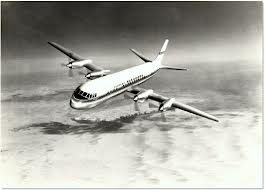Vickers Viscount Turboprop airliner and freighter:
Type:
Turboprop airliner and freighter
History:
Vicker's Viscount was the first turboprop airliner from any nation to
enter service.
The Viscount was one of the results of the UK's wartime Brabazon
Committee, which was set up to define requirements for British postwar
commercial aircraft. Discussions between the committee and Vickers
designers in late 1944, who had already been working on the VC-1
Viking airliner development of the Wellington bomber, resulted in what
was eventually to become the Viscount. The committee's requirement was
for a 24 seat 1000 mile (1600km/868nm) range airliner, and by the end
of 1945 Vickers had selected the Rolls-Royce Dart turboprop engine
that was then under development to power the new aircraft.
In March 1946 the British government placed a contract with Vickers to
build two prototypes of its design (then called Viceroy), one powered
by Darts, the other by Armstrong Siddeley Mamba turboprops. By the
time of the Dart powered prototype's first flight on July 16 1948 the
design had grown to seat 34 and was designated Type 630. The second
prototype, the Type 663, was powered by two Rolls-Royce Tay jet
engines. Airline indifference to the 34 seat Viscount and the
availability of more powerful Dart variants however led Vickers to
stretch the design to seat 40. This development was designated the
Type 700, and first flew on April 19 1950.
Airline interest in the Viscount 700 was much stronger, and after
receiving certification on April 17 1953 it entered service with BEA
the following day. The Viscount was the subject of numerous large
orders including from North America, its smoothness, good operating
economics and pressurisation contributing to its success.
Capitalising on the 700's success Vickers developed the stretched 800
with seating for up to 69, while the final Viscount development was
the 810 with more powerful engines and higher weights.
Powerplants:
700 - Four 1154kW (1547ehp) Rolls-Royce Dart R.Da.3 Mk.505/506
turboprops driving four-blade constant speed propellers.
700D - Four 1297kW (1740ehp) Rolls-Royce R.Da.6 Mk.510s.
800 - Four 1327kW (1780ehp) R.Da.6 Mk.510s, or 1409kW (1890ehp) R.Da.7 Mk.520s.
810 - 1485kW (1990ehp) R.Da.7/1 Mk.525/530s.
Performance:
700D - Max cruising speed 537km/h (290kt), economical cruising speed
521km/h (282kt). Service ceiling 25,500ft. Range with max payload and
no reserves 2140km (1157nm), range with max fuel and 43 passengers
2768km (1496nm).
810 - Max cruising speed 587km/h (318kt), economical cruising speed
565km/h (305kt). Range with 64 passengers 2780km (1500nm), range with
max fuel 2832km (1530nm).
Weights:
700D - Basic empty 17,200kg (37,918lb), max takeoff 29,257kg (64,500lb).
810 - Operating empty 19,959kg (43,200lb), max takeoff 32,866kg (72,500lb).
Dimensions:
700 - Wing span 28.56m (93ft 9in), length with radar 24.94m (81ft
10in), height 8.16m (26ft 9in). Wing area 89.5m2 (963sq ft).
800 - Same except for length 26.11m (85ft 8in).
Capacity:
Flightcrew of two or three. 700 - Typical layouts included 40
passengers at four abreast, or between 47 to 63 at five abreast.
800 - Typical seating for 65 at five abreast and 97cm (38in) pitch.
Production:
Total Viscount production reached 436 aircraft. Approx 3 Viscounts in
service in 2004, all in Africa.







No comments:
Post a Comment